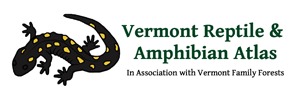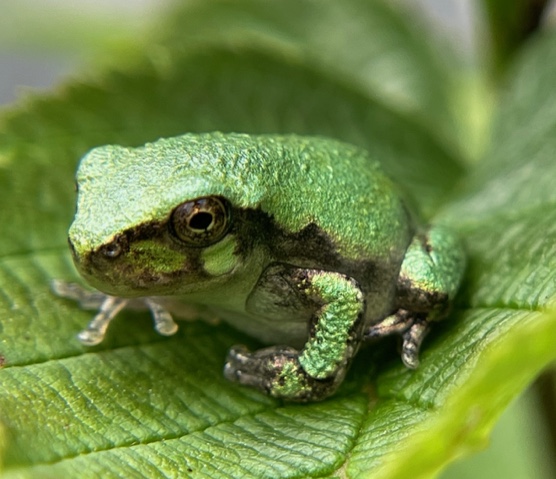
Herp Update: Treefrogs, thanks to Intern – August 30, 2023
Current Herp Activity : Gray Treefrogs
At this time of year we receive many reports of little emerald green frogs that are climbing on plants and homes near ponds and other wetlands. Many people have a hard time identifying these little frogs, and a few have called them Green or Squirrel Treefrogs. However, we have only one species of treefrog in Vermont and it is the Gray Treefrog.
These little frogs that folks are seeing are young Gray Treefrogs that have just transformed from their larval stage and are moving onto land. Adult Gray Treefrogs have bumpy skin and their skin color may be white, gray, or green with a black pattern that resembles the lichen that often grows on tree trunks or rocks. Adult color can vary in shade depending on light exposure and temperature. As a result, an adult Gray Treefrog that appears dark gray on a cold dark day might look white when it is hot and they are exposed to a lot of sun. Still the bumps and the lichenate pattern remain.
The little frogs that are just transforming and leaving the ponds, though, are solid emerald green with no lichenate pattern and their bumps are very small. It is unclear (to me) how many days or weeks after transformation it takes them to develop the lichenate pattern, adult background coloration, and the ability to change color. Still, even the very young frogs usually have a lighter patch under their eyes and expanded toe tips for climbing. Gray Treefrogs of all ages have rounded backs without the ridges of skin that extend backward along the tops of their sides (no dorsolateral ridges).
Erin Talmage, executive director of the Birds of Vermont Museum (BOVM) and part-time employee of the Herp Atlas, took some great photos yesterday (see below) of recently metamorphosed Gray Treefrogs and Spring Peepers near the upper pond at the BOVM in Huntington. Two of her photos show metamorphs that have already lost (resorbed) their tails, the third photo shows a metamorph that is still partially in the water and still has its tail.
The two brown metamorphs are Spring Peepers, one still with a tail, and one that has resorbed (recycled) its tail.
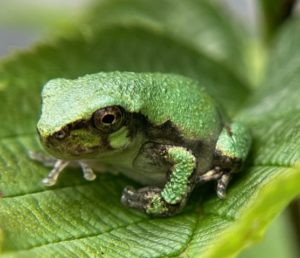
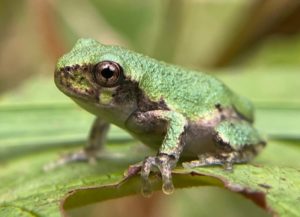
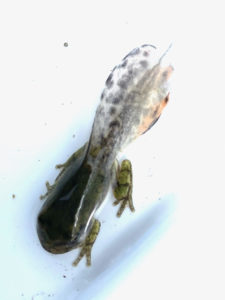
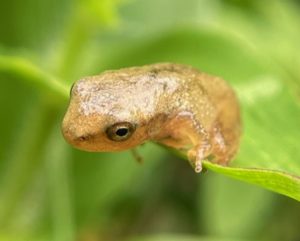
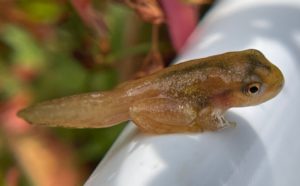
Thanks to our intern Rosy Metcalfe
 This field season, our normal crew (Cindy Brown, Kate Kelly, Erin Talmage, and me) was joined by Rosy Metcalfe. Rosy is getting her masters in Conservation Biology from Antioch University New England and her program requires an internship with an organization doing work related to her major. For her masters thesis she is studying snakes and their habitat associations. She has been a tremendous help with field surveys, research, and office work and we expect to hear more from her in the future.
This field season, our normal crew (Cindy Brown, Kate Kelly, Erin Talmage, and me) was joined by Rosy Metcalfe. Rosy is getting her masters in Conservation Biology from Antioch University New England and her program requires an internship with an organization doing work related to her major. For her masters thesis she is studying snakes and their habitat associations. She has been a tremendous help with field surveys, research, and office work and we expect to hear more from her in the future.
Rosy and I spent one memorable day wading hip deep (without waders) in a newly created pond netting amphibian larvae. Large (and colorful) macrobdellan leeches were all around us, including one that climbed up under her pant leg. Like a true hard-corp herper, she was unfazed.
Thanks, Rosy.
